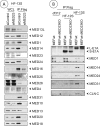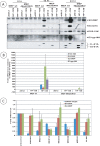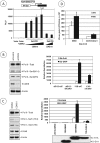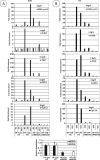Adenovirus L-E1A activates transcription through mediator complex-dependent recruitment of the super elongation complex
- PMID: 23302885
- PMCID: PMC3592126
- DOI: 10.1128/JVI.03046-12
Adenovirus L-E1A activates transcription through mediator complex-dependent recruitment of the super elongation complex
Abstract
The adenovirus large E1A (L-E1A) protein is a prototypical transcriptional activator, and it functions through the action of a conserved transcriptional activation domain, CR3. CR3 interacts with a mediator subunit, MED23, that has been linked to the transcriptional activity of CR3. Our unbiased proteomic analysis revealed that human adenovirus 5 (HAdv5) L-E1A was associated with many mediator subunits. In MED23-depleted cells and in Med23 knockout (KO) cells, L-E1A was deficient in association with other mediator subunits, suggesting that MED23 links CR3 with the mediator complex. Short interfering RNA (siRNA)-mediated depletion of several mediator subunits suggested differential effects of various subunits on transcriptional activation of HAdv5 early genes. In addition to MED23, mediator subunits such as MED14 and MED26 were also essential for the transcription of HAdv5 early genes. The L-E1A proteome contained MED26-associated super elongation complex. The catalytic component of the elongation complex, CDK9, was important for the transcriptional activity of L-E1A and HAdv5 replication. Our results suggest that L-E1A-mediated transcriptional activation involves a transcriptional elongation step, like HIV Tat, and constitutes a therapeutic target for inhibition of HAdv replication.
Figures







Similar articles
-
Comparison of E1A CR3-dependent transcriptional activation across six different human adenovirus subgroups.J Virol. 2010 Dec;84(24):12771-81. doi: 10.1128/JVI.01243-10. Epub 2010 Sep 29. J Virol. 2010. PMID: 20881041 Free PMC article.
-
In vivo association of adenovirus large E1A protein with the human mediator complex in adenovirus-infected and -transformed cells.J Virol. 2002 Sep;76(18):9186-93. doi: 10.1128/jvi.76.18.9186-9193.2002. J Virol. 2002. PMID: 12186902 Free PMC article.
-
Identification of a second independent binding site for the pCAF acetyltransferase in adenovirus E1A.Virology. 2009 Aug 15;391(1):90-8. doi: 10.1016/j.virol.2009.05.024. Epub 2009 Jun 21. Virology. 2009. PMID: 19541337
-
Recent lessons in gene expression, cell cycle control, and cell biology from adenovirus.Oncogene. 2005 Nov 21;24(52):7673-85. doi: 10.1038/sj.onc.1209040. Oncogene. 2005. PMID: 16299528 Review.
-
Modulation of AP-1/ATF transcription factor activity by the adenovirus-E1A oncogene products.Bioessays. 1995 Jul;17(7):621-9. doi: 10.1002/bies.950170708. Bioessays. 1995. PMID: 7646484 Review.
Cited by
-
Adenovirus E1A recruits the human Paf1 complex to enhance transcriptional elongation.J Virol. 2014 May;88(10):5630-7. doi: 10.1128/JVI.03518-13. Epub 2014 Mar 5. J Virol. 2014. PMID: 24600005 Free PMC article.
-
P-TEFb as A Promising Therapeutic Target.Molecules. 2020 Feb 14;25(4):838. doi: 10.3390/molecules25040838. Molecules. 2020. PMID: 32075058 Free PMC article. Review.
-
P-TEFb goes viral.Inside Cell. 2016 Apr;1(2):106-116. doi: 10.1002/icl3.1037. Epub 2015 Nov 25. Inside Cell. 2016. PMID: 27398404 Free PMC article. Review.
-
Divergent Evolution of E1A CR3 in Human Adenovirus Species D.Viruses. 2019 Feb 8;11(2):143. doi: 10.3390/v11020143. Viruses. 2019. PMID: 30744049 Free PMC article.
-
Hacking the Cell: Network Intrusion and Exploitation by Adenovirus E1A.mBio. 2018 May 1;9(3):e00390-18. doi: 10.1128/mBio.00390-18. mBio. 2018. PMID: 29717008 Free PMC article. Review.
References
-
- Berk AJ. 2005. Recent lessons in gene expression, cell cycle control, and cell biology from adenovirus. Oncogene 24:7673–7685 - PubMed
-
- Berk AJ, Lee F, Harrison T, Williams J, Sharp PA. 1979. Pre-early adenovirus 5 gene product regulates synthesis of early viral messenger RNAs. Cell 17:935–944 - PubMed
-
- Green M, Loewenstein PM, Pusztai R, Symington JS. 1988. An adenovirus E1A protein domain activates transcription in vivo and in vitro in the absence of protein synthesis. Cell 53:921–926 - PubMed
Publication types
MeSH terms
Substances
Grants and funding
LinkOut - more resources
Full Text Sources
Other Literature Sources
Research Materials
Miscellaneous

